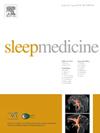与呼吸努力相关的唤醒评分值得付出努力吗?--一项比较 4% 和 3% 呼吸暂停评分规则结果的研究
IF 3.8
2区 医学
Q1 CLINICAL NEUROLOGY
引用次数: 0
摘要
研究目的呼吸努力相关唤醒(RERA)已与呼吸暂停和低通气合并为呼吸紊乱指数(RDI)。RERA 的特征是上气道用力≥ 10 秒,最后以唤醒结束,但不符合低通气标准。最近对呼吸暂停定义的修改包括气流在 10 秒内减少≥30%,同时伴有 3% 的血氧饱和度降低或唤醒。因此,许多以前被归类为 RERAs 的事件现在将被纳入 3% 低通气中,这可能会减少被记为 RERAs 的事件数量。我们假设 3% 的呼吸暂停-低通气指数(3%AHI)将与 4% 的呼吸暂停-低通气指数(RDI)相近,而 3% 的呼吸暂停-低通气指数(RERAs)的数量可以忽略不计。研究问题 从 4% 到 3% 的低通气规则的过渡如何影响呼吸暂停-低通气指数(RERAs)在临床实践中的重要性,以及我们应该如何使用不同的低通气规则将呼吸暂停-低通气指数(AHI)和呼吸暂停-低通气指数(RDI)联系起来?结果在 76 项诊断研究中(平均年龄 47.5 岁,男性占 47.4%),3% RERA 指数[0.8 (0.0, 3.1)][中位数 (Q1, Q3)]明显低于 4% RERA 指数[3.5 (1.0, 7.3)]。3%AHI 比 4%RDI 高 3.07 ± 9.23(平均 ± SD)(P = 0.005)。在所有年龄组中,3%AHI 比 4%AHI 高 8.63 ± 8.86(p = 0.001)。这主要是由于低通气指数增加所致(+8.51 ± 9.03,p < 0.001)。在阻塞性睡眠呼吸暂停(OSA)患者中,3%RERA 对 3%RDI 的贡献率为 4.3%,而 4%RERA 对 4%RDI 的贡献率为 27.7%。解释3%RDI 和 3%AHI 均高于 4%RDI,主要是由于识别出更多低通气事件,导致更多患者被归类为 OSA。标准的这一变化使使用不同低通气规则评分的睡眠研究之间低通气和 RERA 贡献的比较变得更加复杂。本文章由计算机程序翻译,如有差异,请以英文原文为准。
Are scoring respiratory effort-related arousals worth the effort? --A study comparing outcomes between 4 % vs 3 % hypopnea scoring rules
Study objectives
The respiratory effort-related arousal (RERA) has been combined with apneas and hypopneas into the respiratory disturbance index (RDI). RERAs are characterized by ≥ 10 s of increasing upper airway effort terminating in arousal without meeting hypopnea criteria. The recent change to hypopnea definitions now includes a ≥30 % reduction in airflow for 10 s with EITHER a 3 % oxygen desaturation OR an arousal. Consequently, many events previously categorized as RERAs will now be included in the 3 % hypopneas, likely reducing the number of events scored as RERAs. We hypothesized that the 3 % apnea-hypopnea index (3%AHI) would approximate the 4%RDI, with the number of 3 % RERAs being negligible.
Research question
How does the transition from the 4 % to the 3 % hypopnea rules impact the significance of RERAs in clinical practice, and how we should relate the AHI and RDI using the different hypopnea rules?
Methods
We prospectively collected 76 consecutive polysomnography results in 4 adult age groups. We re-scored the respiratory events utilizing both the 3 % and the 4 % hypopnea rules and compared the outcomes.
Results
Among 76 diagnostic studies (mean age 47.5 years, males 47.4 %), the 3 % RERA index [0.8 (0.0, 3.1)] [median (Q1, Q3)] was significantly lower than the 4 % RERA index [3.5 (1.0, 7.3)]. The 3%AHI was 3.07 ± 9.23 (mean ± SD) higher than the 4%RDI (p = 0.005). The 3%AHI was 8.63 ± 8.86 higher than the 4%AHI in all age groups (p < 0.001). This was mainly due to an increased hypopnea index (+8.51 ± 9.03, p < 0.001). In patients with obstructive sleep apnea (OSA), the 3%RERA contributes 4.3 % to the 3%RDI, while the 4%RERA contributes 27.7 % to the 4%RDI.
Interpretations
Both 3%RDI and 3%AHI are higher than the 4%RDI, primarily due to identification of more hypopnea events, resulting in more patients being classified as having OSA. This change in criteria complicates the comparison of hypopnea and RERA contributions between sleep studies scored using the different hypopnea rules.
求助全文
通过发布文献求助,成功后即可免费获取论文全文。
去求助
来源期刊

Sleep medicine
医学-临床神经学
CiteScore
8.40
自引率
6.20%
发文量
1060
审稿时长
49 days
期刊介绍:
Sleep Medicine aims to be a journal no one involved in clinical sleep medicine can do without.
A journal primarily focussing on the human aspects of sleep, integrating the various disciplines that are involved in sleep medicine: neurology, clinical neurophysiology, internal medicine (particularly pulmonology and cardiology), psychology, psychiatry, sleep technology, pediatrics, neurosurgery, otorhinolaryngology, and dentistry.
The journal publishes the following types of articles: Reviews (also intended as a way to bridge the gap between basic sleep research and clinical relevance); Original Research Articles; Full-length articles; Brief communications; Controversies; Case reports; Letters to the Editor; Journal search and commentaries; Book reviews; Meeting announcements; Listing of relevant organisations plus web sites.
 求助内容:
求助内容: 应助结果提醒方式:
应助结果提醒方式:


